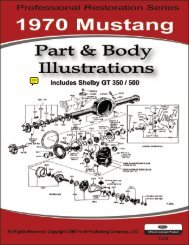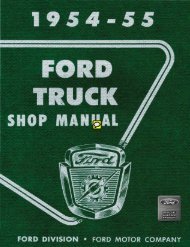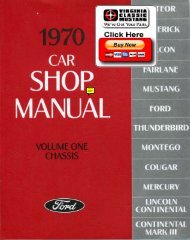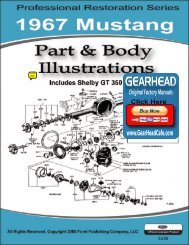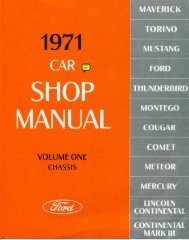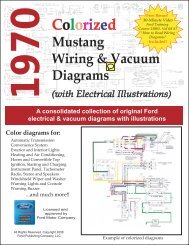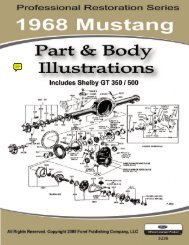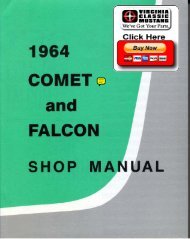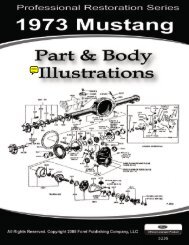DEMO - 1965 Ford Truck Shop Manual - ForelPublishing.com
DEMO - 1965 Ford Truck Shop Manual - ForelPublishing.com
DEMO - 1965 Ford Truck Shop Manual - ForelPublishing.com
Create successful ePaper yourself
Turn your PDF publications into a flip-book with our unique Google optimized e-Paper software.
PART 2-4-MIDLAND DIAPHRAGM-TYPE DASH-MOUNTED BOOSTER 2-41<br />
by additional movement of the control<br />
valve diaphragm.<br />
As the air is admitted, it flows<br />
through a cavity in the control valve<br />
housing to the back side of the rear<br />
vacuum piston, through the piston<br />
rod, out the four holes in the piston<br />
rod to the back side of the front<br />
vacuum piston. Air pressure on the<br />
back side of both pistons working<br />
with vacuum on the front side of<br />
both pistons, sets the pistons in<br />
motion transmitting their <strong>com</strong>bined<br />
force to the hydraulic piston in the<br />
hydraulic cylinder, through the push<br />
rod.<br />
As the hydraulic piston starts to<br />
move, the check ball seats, trapping<br />
fluid under pressure ahead of the<br />
piston. This initial hydraulic pressure<br />
from the master cylinder is multiplied<br />
several times.<br />
When the brake pedal is released,<br />
hydraulic pressure in the master cylinder,<br />
and in the control valve piston<br />
cavity of the booster, decreases. The<br />
vacuum diaphragm return spring<br />
moves the diaphragm and the control<br />
valve piston rearward permitting<br />
spring pressure to seat the atmospheric<br />
valves, and unseat the vacuum<br />
valve. The check valve in the<br />
hydraulic cylinder closes. As the vacuum<br />
valve opens, air in the booster<br />
is exhausted into the intake manifold<br />
of the engine, allowing the vacuum<br />
piston return spring to return<br />
the vacuum and hydraulic cylinder<br />
pistons to their released position. As<br />
the hydraulic cylinder piston returns,<br />
the check ball opens permitting brake<br />
fluid to flow through the piston, allowing<br />
it to return to its fully released<br />
position.<br />
Normal operation of the booster<br />
is such that both vacuum pistons are<br />
set in motion at the same time. However,<br />
when a fast, hard brake stop<br />
is made, the front vacuum piston<br />
may lag behind the rear vacuum<br />
piston. A fast application is used to<br />
over<strong>com</strong>e the lag of the front piston<br />
by admitting an additional volume<br />
of air to the back side of the<br />
front piston. Vacuum, from the constant<br />
vacuum line, is applied to the<br />
back side of the fast application valve<br />
diaphragm. The fast application valve<br />
is held in a closed position by a<br />
spring. When a fast or hard brake<br />
stop is made, atmospheric pressure<br />
is transmitted through the control<br />
by-pass tube to the front side of the<br />
fast application valve diaphragm.<br />
This causes the diaphragm to move<br />
to the left, lifting the valve from its<br />
seat and admitting a large volume of<br />
air from the air inlet by-pass hose to<br />
the back side of the front piston, thus<br />
providing the same degree of power<br />
to both vacuum pistons.<br />
MIDLAND DIAPHRAGM-<br />
TYPE, DASH-MOUNTED<br />
BOOSTER<br />
The booster consists of a vacuum<br />
chamber, atmospheric valve, control<br />
valve plunger assembly, diaphragm<br />
and an atmospheric chamber (Figs.<br />
8, 9, and 10).<br />
Atmospheric pressure is present at<br />
all times in the atmospheric chamber<br />
at the front side of the atmospheric<br />
valve. The air intake to the atmospheric<br />
chamber is protected by an<br />
air filter. The atmospheric chamber<br />
is separated from the vacuum chamber<br />
by the bellows assembly within<br />
the vacuum chamber.<br />
Vacuum is present at all times in<br />
that area of the vacuum chamber<br />
y<br />
MASTER<br />
CYLINDER<br />
PISTON<br />
VACUUM MANIFOLD<br />
|P|VACUUM<br />
^ATMOSPHERIC PRESSURE<br />
FIG.<br />
HYDRAULIC<br />
CHECK VALVE<br />
VACUUM<br />
MASTER CYLINDER<br />
PUSH ROD<br />
BELLOWS<br />
8—Booster in Applied Position<br />
ATMOSPHERIC PRESSURE<br />
RESERVOIR<br />
FILTER<br />
FIG. 9-Booster in Holding Position<br />
forward of the diaphragm. Vacuum<br />
is supplied through a hose from the<br />
intake manifold to the vacuum manifold<br />
and check valve assembly on the<br />
booster body. With this integral<br />
check valve and vacuum chamber,<br />
it is possible to obtain several power<br />
assisted brake applications with the<br />
engine shut off. This arrangement<br />
makes a vacuum reservoir unnecessary.<br />
For a greater reserve, however,<br />
a vacuum reservoir is available as<br />
optional equipment on some trucks.<br />
Either vacuum from the forward<br />
side of the diaphragm or air from<br />
the bellows (atmospheric chamber)<br />
can be connected to the rear side of<br />
the diaphragm through porting in the<br />
control valve hub and the plunger<br />
assembly.<br />
APPLIED POSITION<br />
As the brake pedal is depressed,<br />
the valve operating rod and valve<br />
plunger assembly move forward <strong>com</strong>-<br />
DIAPHRAGM<br />
ATMOSPHERIC<br />
PORT OPEN<br />
VACUUM PORT<br />
CLOSED<br />
ATMOSPHERIC<br />
PORT CLOSED<br />
o\ BRAKE<br />
PEDAL<br />
H1273-A<br />
H1274-A




